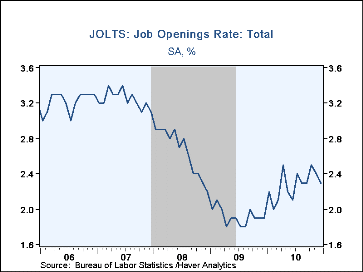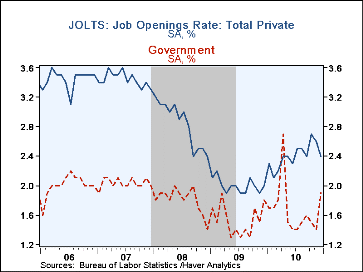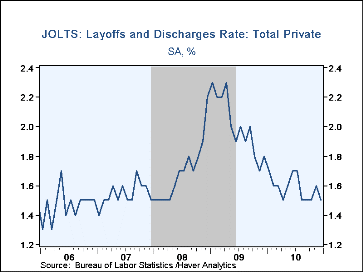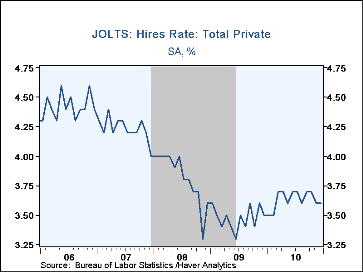 Global| Feb 08 2011
Global| Feb 08 2011JOLTS: U.S. Job Openings Rate Pulls Back
by:Tom Moeller
|in:Economy in Brief
Summary
The Bureau of Labor Statistics reported in its Job Openings & Labor Turnover Survey (JOLTS) that the December job openings rate slipped to 2.3% from an upwardly revised 2.4% during November. For the full year the job opening rate [...]
The Bureau of Labor Statistics reported in its Job Openings & Labor Turnover Survey (JOLTS) that the December job openings rate slipped to 2.3% from an upwardly revised 2.4% during November. For the full year the job opening rate improved modestly to 2.3%, its highest since 2007. These levels remained improved versus the recession low of 1.8%. The job openings rate is the number of job openings on the last business day of the month as a percent of total employment plus job openings. Job availability slipped m/m from its highest level since August 2008. Nevertheless, job availability recovered roughly one-quarter last year after the 17.8% decline during 2009.
The private-sector job openings rate also fell m/m to 2.4%, its lowest since June. It was down for the fourth month in the last five. For the full year, however, openings rose 23.7%. Factory sector openings fell sharply during December and by one-quarter for the full year. Professional & business services job openings rose 5.3% in December but ticked down 0.5% for the year. The job openings rate in government remained a low 1.4%. However, it was up for the year due to a mid-year surge with Census taking..
The hires rate remained low at 3.2% for the fourth month in the last five. The hires rate is the number of hires during the month divided by employment. The 3.6% rate in the private sector easily surpassed the government's at 1.4%, The actual number of hires rose 4.5% last year, after three years of decline. Hires in professional & business were the strongest with a 12.6% full-year rise followed by a 13.7% gain in manufacturing.
The job separations rate held at 3.2% for the fourth month in the last five, near its lowest. The actual number of separations ticked 0.8% lower m/m but were off 6.6% for the year. Separations include quits, layoffs, discharges, and other separations as well as retirements. The layoff & discharge rate alone held m/m at a reduced 1.4% and fell y/y to 17.3%, its lowest since 2007. The private sector layoff rate fell for the year to 19.0%.
The JOLTS survey dates only to December 2000 and the figures are available in Haver's USECON database.
| JOLTS (Job Openings & Labor Turnover Survey) | Dec | Nov | Oct | Dec'09 | 2010 | 2009 | 2008 |
|---|---|---|---|---|---|---|---|
| Job Openings, Total | |||||||
| Rate (%) | 2.3 | 2.4 | 2.5 | 1.9 | 2.3 | 1.9 | 2.2 |
| Total (000s) | 3,063 | 3,202 | 3,328 | 2,531 | 3,063 | 2,531 | 3,078 |
| Hires, Total | |||||||
| Rate (%) | 3.2 | 3.2 | 3.3 | 3.1 | 39.1 | 37.3 | 41.1 |
| Total (000s) | 4,184 | 4,214 | 4,249 | 3,997 | 50,838 | 48,649 | 56,082 |
| Layoffs & Discharges, Total | |||||||
| Rate (%) | 1.3 | 1.4 | 1.3 | 1.6 | 17.3 | 21.2 | 18.0 |
| Total (000s) | 1,838 | 1,854 | 1,755 | 2,049 | 22,628 | 27,683 | 24,589 |
Tom Moeller
AuthorMore in Author Profile »Prior to joining Haver Analytics in 2000, Mr. Moeller worked as the Economist at Chancellor Capital Management from 1985 to 1999. There, he developed comprehensive economic forecasts and interpreted economic data for equity and fixed income portfolio managers. Also at Chancellor, Mr. Moeller worked as an equity analyst and was responsible for researching and rating companies in the economically sensitive automobile and housing industries for investment in Chancellor’s equity portfolio. Prior to joining Chancellor, Mr. Moeller was an Economist at Citibank from 1979 to 1984. He also analyzed pricing behavior in the metals industry for the Council on Wage and Price Stability in Washington, D.C. In 1999, Mr. Moeller received the award for most accurate forecast from the Forecasters' Club of New York. From 1990 to 1992 he was President of the New York Association for Business Economists. Mr. Moeller earned an M.B.A. in Finance from Fordham University, where he graduated in 1987. He holds a Bachelor of Arts in Economics from George Washington University.










